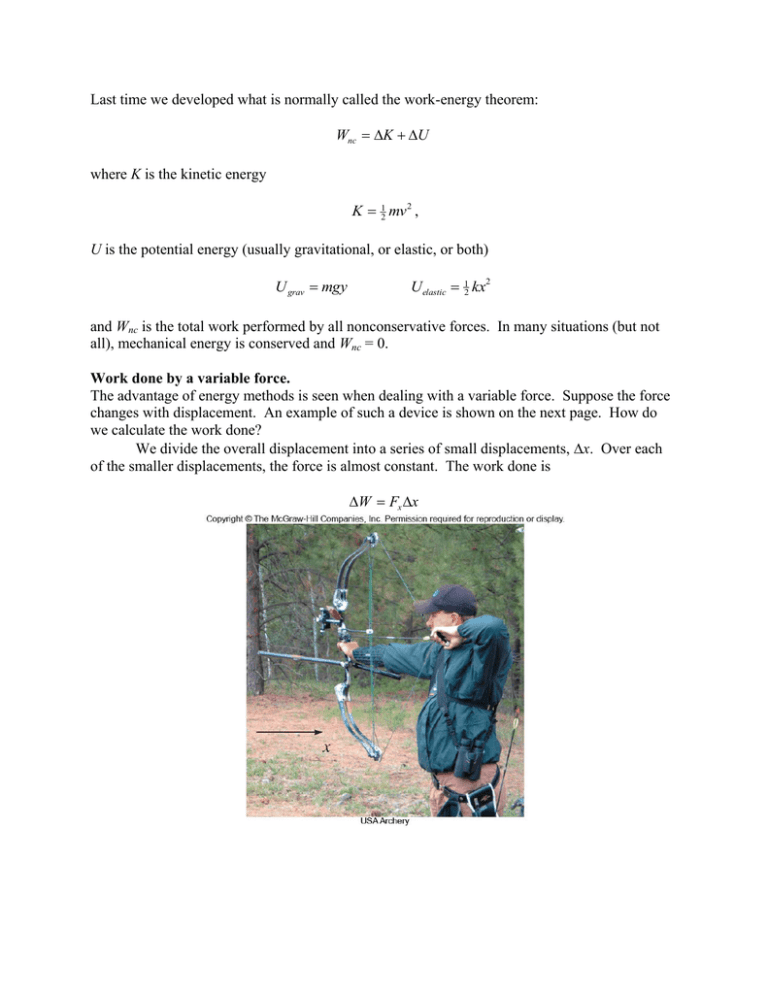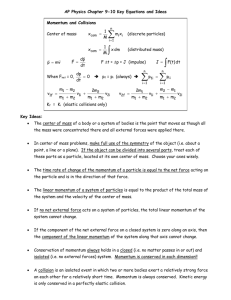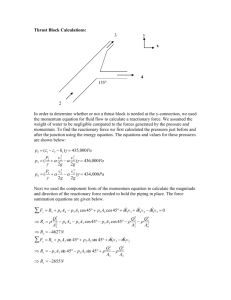Last time we developed what is normally called the work-energy... K ,
advertisement

Last time we developed what is normally called the work-energy theorem: Wnc K U where K is the kinetic energy K 12 mv 2 , U is the potential energy (usually gravitational, or elastic, or both) U grav mgy U elastic 12 kx2 and Wnc is the total work performed by all nonconservative forces. In many situations (but not all), mechanical energy is conserved and Wnc = 0. Work done by a variable force. The advantage of energy methods is seen when dealing with a variable force. Suppose the force changes with displacement. An example of such a device is shown on the next page. How do we calculate the work done? We divide the overall displacement into a series of small displacements, x. Over each of the smaller displacements, the force is almost constant. The work done is W Fx x Fig. 06.26 The total work is the area under the curve shown above. While we did not explain it last time, this procedure was used to find the gravitational potential energy for an object far from the Earth U GM E m r Hooke’s Law and Ideal Springs The force exerted by the archer increases as the bowstring is drawn back. Robert Hooke proposed an ideal spring where the force is proportional to the displacement Fx kx The displacement of the spring from the relaxed position is x. The constant k, is called the spring constant. It is measured in N/m and it gives the strength of the spring. The larger k is, the stiffer the spring. The minus sign indicates that if the spring is stretched to the right, the spring pulls back to the left and vice versa. Elastic Potential Energy As the spring is pulled (or pushed) from its relaxed position, work is done on it. The work done is independent of the path taken and accordingly, a potential energy can be defined. The elastic potential energy is found to be U elastic 12 kx2 Note that U = 0 when x = 0. Power Sometimes the rate of energy conversion is important. We use the term power to refer to the rate of energy conversion. P E t Power is measured in Joules/second or watts (W). Be careful with W for work and W for watts. Remember that work changes the mechanical energy of the system. E t Fr cos t Fv cos P Problem 82. A spring gun (k = 28 N/m) is used to shoot a 56-g ball horizontally. Initially the spring is compressed by 18 cm. The ball loses contact with the spring a leaves the gun when the spring is still compressed by 12 cm. What is the speed of the ball when it hits the ground 1.4 m below the gun? Solution: This appears to be a projectile problem. It is an energy problem with two potential energies. Take the initial position to be at the top and the final position just before it hits the ground, K1 U1 K 2 U 2 0 12 kx1 mgy1 12 mv2 12 kx2 0 2 2 2 v2 2 gy1 k ( x1 x2 ) / m 2 2 2(9.8 m/s 2 )(1.4 m) (28 N/m)((0.18 m) 2 (0.12 m) 2 ) /(0.056 kg ) 6.04 m/s Problem 91. A 1500-kg car coasts in neutral down a 2.0º hill. The car attains a terminal speed of 20.0 m/s. (a) How much power must the engine deliver to drive the car on a level road at 20.0 m/s? (b) If the maximum useful power that can be delivered by the engine is 40.0 kW, what is the steepest hill the car can climb at 20.0 m/s? Solution: At the terminal speed, the weight of the car is opposed by air resistance. The free body diagram is N Fair mg (a) For the x-component (along the incline) F x ma x mg sin Fair 0 Fair mg sin (1500kg )(9.8 m/s 2 ) sin 2 513 N The power required is keep the car moving at 20 m/s P Fv cos Fair v cos180 (513 N)(20 m/s) cos180 10,300 W (b) Again a free body diagram is helpful. N Fmotor Fair mg Climbing with constant speed, F x ma x Fmotor mg sin Fair 0 Fmotor Fair mg sin The maximum power supplied by the engine is 40.0 kW. The power is P Fmotor v cos ( Fair mg sin )v cos 0 Fair v mgv sin sin P Fair v mgv 40.0 103 W (513 N)(20 m/s) (1500kg )(9.8 m/s2 )(20 m/s) 0.101 This corresponds to a 5.8º angle. Chapter 7 Linear Momentum From page 226 In Chapter 4 we learned how to determine the acceleration of an object by finding the net force acting on it and applying Newton’s second law of motion. If the force happens to be constant, then the resulting constant acceleration enables us to calculate changes in velocity and position. Calculating velocity and position changes when the forces are not constant is much more difficult. In many cases, the forces cannot even be easily determined. Conservation of energy is one tool that enables us to draw conclusions about motion without knowing all the details of the forces acting…. In this chapter we develop another conservation law. Conservation laws are powerful tools. If a quantity is conserved, then no matter how complicated the situation, we can set the value of the conserved quantity at one time equal to its value at a later time…. The new conserved quantity, momentum, is a vector quantity, in contrast to energy, which is a scalar. When momentum is conserved, both the magnitude and direction of the momentum must be constant. Equivalently, the x- and y-components of momentum are constant. When we find the total momentum of more than one object, we must add the momentum vectors according to the procedure by which vectors are always added. Definition of linear momentum An object with mass m and moving with velocity v has linear momentum p p mv Impulse-Momentum Theorem Starting with Newton’s second law F ma and using the definition of acceleration v a t we have v F m t If the mass is constant, we can pull it inside the operator (mv ) F t p F t p Ft This states that the change in linear momentum is caused by the impulse. The quantity Ft is called the impulse. For situations where the force is not constant, we use the average force, impulse Fav t Restatement of Newton’s second law There is a more general form of Newton’s second law p F lim t 0 t The net force is the rate of change of momentum.







